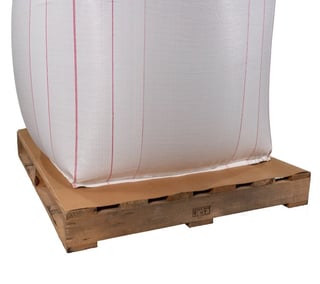Coated or Uncoated? Choosing the Proper FIBC for Your Product.
Coated or uncoated? We get this question a lot. As a leading supplier of FIBC bulk bags, our job is to educate our customers and put them in a..
November 17, 2021
Dry flowable powders may be susceptible to moisture intrusion when packed in a Flexible Intermediate Bulk Container (FIBC or bulk bag).
Products that are sensitive to moisture include cement-based building products, food ingredients, and hazardous chemicals. Products such as Quicklime and spent catalyst can release dangerously high amounts of heat upon contact with water. Properly protecting your bulk powder products reduces or eliminates the risk of spoilage, clumping, and contamination. In extreme cases, it can prevent a catastrophic accident or spill.
What is a coated FIBC? A coated FIBC is an FIBC that is made with standard woven fabric that has been laminated with a PP film layer. The film layer is typically 1.0mil or less and can be applied to the inside or outside of the bag’s fabric.
The PP film layer reduces airflow, moisture transmission, and dusting of the contents. The film layer itself does not have any strength properties. Coated FIBCs may also be referred to as laminated or non-breathable bags. In general, coated bags are ideal for particle sizes smaller than 125 microns or 120 mesh. For more information on coated vs. uncoated bags visit our blog post here.

What is a lined FIBC? A lined FIBC is a bulk bag that is equipped with an internal film liner. A lined bulk bag offers the best form of protection against moisture intrusion and product sifting. The liner can be made with a variety of material types including polyethylene, polypropylene, aluminum foil, and Ethylene-vinyl alcohol copolymer (EVOH). Liners can be form fit or tubular.
.png?width=216&height=242&name=FIBC%20Liner-png%20(1).png)
The liner can be loosely inserted into the bag, attached with tabs, or glued into the body of the bag. In addition, liners can be cuffed into the bag’s openings for easy loading and unloading. Lined bags are ideal for food ingredients, ultra-fine materials, cementitious products, and hazardous chemicals.
For more information visit our FIBC liner page here.
Polyethylene pallet covers are a simple but effective way to protect your product from moisture and exposure from the Sun. Poly covers are essentially a large trash bag that fits over the palletized material. Palletized material can be an FIBC, 25kg paper bags, or boxes.
Covers come in a variety of sizes, colors, and film thicknesses. In general, poly covers are secured to the pallet with stretch film or strapping. Poly covers can be printed for product identification.
A heat shrink poly film cover looks and feels like a standard poly cover. The primary difference is that heat shrink film is designed to shrink or mold itself around the product being palletized when heat is applied. Heat shrink requires a heat gun to work properly and requires training.
Shrink film is extremely strong and can stabilize pallet loads while reducing or eliminating moisture intrusion. Shrink film covers can also be printed for product identification.
As temperatures rise and fall, ground level moisture can accumulate from underneath the bulk bag. A slip sheet placed between the pallet and the FIBC is a simple and effective way to prevent moisture intrusion from the ground. A Slip Sheet is a thin sheet of heavy-duty paperboard, corrugated fiberboard, or plastic used as a load support device for shipping palletized material.
Slip sheets are typically placed between a pallet and the palletized material to prevent palletized products from incurring damage during storage, handling, and shipping. For more information on paperboard slip sheets, visit our Slip Sheet page here.

.png?width=432&height=288&name=slipsheet%20(1).png)
Southern Packaging, LP stocks coated and lined FIBCs, poly covers, shrink film, and slip sheets to help protect your products from moisture during and after packaging.
For more information on our stock inventory and/or custom orders, contact a member of our experienced sales team today. Email us info@southernpackaginglp.com
REQUEST A QUOTE